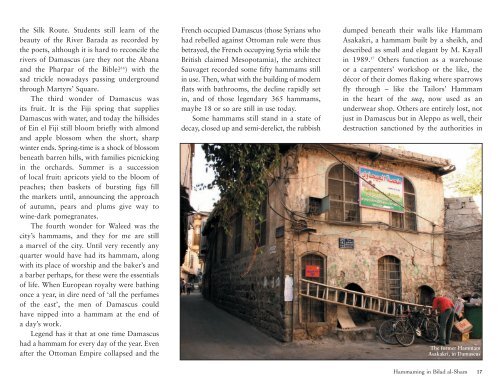Download an excerpt - Garnet Publishing
Download an excerpt - Garnet Publishing
Download an excerpt - Garnet Publishing
Create successful ePaper yourself
Turn your PDF publications into a flip-book with our unique Google optimized e-Paper software.
the Silk Route. Students still learn of the<br />
beauty of the River Barada as recorded by<br />
the poets, although it is hard to reconcile the<br />
rivers of Damascus (are they not the Ab<strong>an</strong>a<br />
<strong>an</strong>d the Pharpar of the Bible? 16 ) with the<br />
sad trickle nowadays passing underground<br />
through Martyrs’ Square.<br />
The third wonder of Damascus was<br />
its fruit. It is the Fiji spring that supplies<br />
Damascus with water, <strong>an</strong>d today the hillsides<br />
of Ein el Fiji still bloom briefly with almond<br />
<strong>an</strong>d apple blossom when the short, sharp<br />
winter ends. Spring-time is a shock of blossom<br />
beneath barren hills, with families picnicking<br />
in the orchards. Summer is a succession<br />
of local fruit: apricots yield to the bloom of<br />
peaches; then baskets of bursting figs fill<br />
the markets until, <strong>an</strong>nouncing the approach<br />
of autumn, pears <strong>an</strong>d plums give way to<br />
wine-dark pomegr<strong>an</strong>ates.<br />
The fourth wonder for Waleed was the<br />
city’s hammams, <strong>an</strong>d they for me are still<br />
a marvel of the city. Until very recently <strong>an</strong>y<br />
quarter would have had its hammam, along<br />
with its place of worship <strong>an</strong>d the baker’s <strong>an</strong>d<br />
a barber perhaps, for these were the essentials<br />
of life. When Europe<strong>an</strong> royalty were bathing<br />
once a year, in dire need of ‘all the perfumes<br />
of the east’, the men of Damascus could<br />
have nipped into a hammam at the end of<br />
a day’s work.<br />
Legend has it that at one time Damascus<br />
had a hammam for every day of the year. Even<br />
after the Ottom<strong>an</strong> Empire collapsed <strong>an</strong>d the<br />
French occupied Damascus (those Syri<strong>an</strong>s who<br />
had rebelled against Ottom<strong>an</strong> rule were thus<br />
betrayed, the French occupying Syria while the<br />
British claimed Mesopotamia), the architect<br />
Sauvaget recorded some fifty hammams still<br />
in use. Then, what with the building of modern<br />
flats with bathrooms, the decline rapidly set<br />
in, <strong>an</strong>d of those legendary 365 hammams,<br />
maybe 18 or so are still in use today.<br />
Some hammams still st<strong>an</strong>d in a state of<br />
decay, closed up <strong>an</strong>d semi-derelict, the rubbish<br />
dumped beneath their walls like Hammam<br />
Asakakri, a hammam built by a sheikh, <strong>an</strong>d<br />
described as small <strong>an</strong>d eleg<strong>an</strong>t by M. Kayall<br />
in 1989. 17 Others function as a warehouse<br />
or a carpenters’ workshop or the like, the<br />
décor of their domes flaking where sparrows<br />
fly through – like the Tailors’ Hammam<br />
in the heart of the suq, now used as <strong>an</strong><br />
underwear shop. Others are entirely lost, not<br />
just in Damascus but in Aleppo as well, their<br />
destruction s<strong>an</strong>ctioned by the authorities in<br />
The former Hammam<br />
Asakakri, in Damascus<br />
Hammaming in Bilad al-Sham 17


